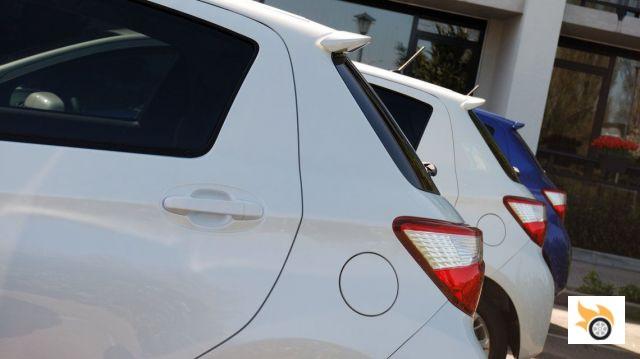The current generation is updated with a second restyling (third if we count the hybrid model, which came out with a different image) and will last until a completely new generation after 2020, already with TNGA architecture. Toyota claims to have listened to what customers were asking for and has updated the aspects in which the Yaris did not shine so much. There will even be a sports version (GRMN with 1.8 engine with compressor), but it won't be here until early next year.
The start of sales is imminent, it will be here in a couple of weeks.
Currently the Yaris range is already 100% petrol, in fact, they don't sell the petrol version (1.4 diesel) in Spain since September 2015. The access engine remains the 1.0 VVT-i of 69 ponys, and the 1.33 VVT-i gives way to the 1.5 VVT-iE of 111 hp; the hybrid remains as it was. There are not only aesthetic changes, but also dynamic and interior. Toyota gives this data: 900 references are new, the facelift has cost 900 million euros. Therefore, it is more than a mere change of bumpers, and for the same price is more equipped than before.
The Yaris adopts a new catamaran-inspired front end, but compared to the model it replaces (which we recently tested) it's less comic book. Although the grille has grown a lot, the effective space through which the air passes is the same; the Cx is unchanged. The LED daytime running light (except for the base model) joins the trim that goes on the way to the Toyota badge. I think I can safely say that the Yaris now has a very cool design, with just the right level of charging. In a way it reminds me of some Lexus.
I asked the head of the Yaris in Europe, Yasunori Suezawa, if such a huge grille would have the problem of excessive cooling, which would mainly affect the hybrid. His answer reassured me, no more air gets in (it's an optical effect) and there are no variable flaps because they don't fit (ecoflaps, active grille, etc). The Yaris Feel! have a honeycomb design, more racing, staggered horizontal bars on the others.
Tokyo Red and Nebula Blue are incorporated into the range of colors, has 10 shades available.
One of the most important new features is the possibility of having two-tone bodywork (800 euros extra), with the black roof, the top of the doors, and the three full pillars. In reality it is a vinyl, it is not a special process of painting - case of the Renault Captur - but it is undoubtedly much more attention-grabbing. On the lower sides we see some new moldings, which can be black or chrome, which make the Yaris more visible. At the rear, the light clusters are completely new, as well as the tailgate and bumpers, which together with the reflectors have false air vents. The designs of the alloy wheels have also been updated.
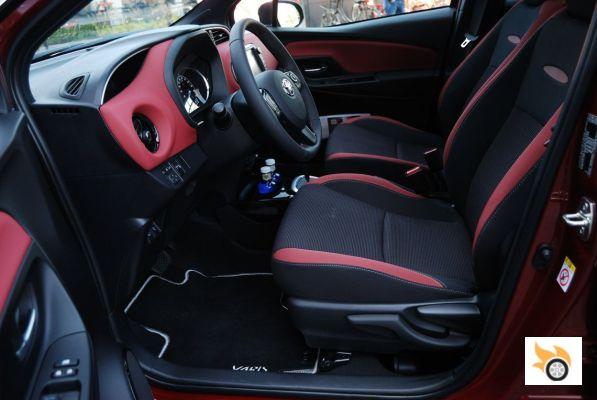
Inside the changes are more or less noticeable depending on the finish. Where the difference sings the most is in the two-tone, because the interior has four additional combinations: blue/black, burgundy with red/black, warm gray with bronze/black and white/black. On all other models there is the classic black/grey, and the Advance will be available with leather upholstery. The fabric upholstery has improved, the car wants to be less bland, and it succeeds.
Let's take a look at the dashboard. The side air vents are still circular, but adopt a propeller design, better looking. The instrumentation is new, finally the Yaris enters modernity in this chapter. Except for the most bare-bones model, it has four analogue dials and a central 4.2-inch screen with a variety of information. It's not exactly the same as in models like the Auris, Avensis or C-HR, which have more sophisticated graphics; this one is a bit simpler. In the hybrid the tachometer is replaced by a potentiometer.
Some auxiliary controls have changed, they are easier to use.
The steering wheel has changed the on/off buttons for the phone and replaces them with a four-way cursor to move through the menus for the computer, navigation, multimedia system, phone and driving assists. No more sticking your hand inside the steering wheel rim to change the information displayed by the computer, hallelujah! It's a pity they haven't taken the opportunity to stretch the steering wheel more, because for my taste the steering wheel doesn't come out enough and I don't feel comfortable. Other drivers won't notice that, it depends a lot on the morphology of each driver.
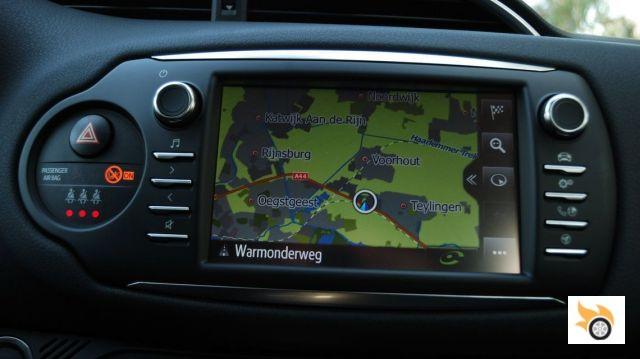
The Toyota Touch 2 multimedia system is a slight improvement over the 2016 version, although it seems that previous Yaris can be upgraded. During the dynamic test in Holland we were able to check the operation of the Coyote application, which was singing fixed radars, traffic light cameras and possible locations of mobile controls. It still doesn't have Apple CarPlay or Android Auto connectivity. The reason? Toyota wants to focus on its own platform and not rely on third-party systems, I'm convinced that if they wanted to do that, they would have done it already.
The rear seatbelts are now more effective, they have pyrotechnic pre-tensioners and load limiters; the airbags have been optimized as well
The interior is noticeably quieter. The manufacturer has taken care to reduce noise entering the interior in several places at the same time, including subframe and drive shafts, according to their data it is up to 5.5 decibels quieter. The truth is that at least up to 120 km/h the Yaris is a relatively quiet car, unless the engines are revved very high. The hybrid is the one that stands out the most in that sense, the loudest is the three-cylinder, but it's not an ugly sound: it's a pleasure to drive it at the injection cut-off, it won't go very far, but it's cool.
Passengers will also notice that the suspension is a bit more comfortable, the hardness of the springs and the valves of the shock absorbers have been recalibrated. It doesn't seem to get any worse in terms of handling (Holland is like an ironing board, mind you) but I found it more comfortable than the previous model, especially the rear end. It also seems to have improved the hybrid in acceleration phases, it has several changes in the intake and exhaust silencer. Possibly it makes less noise than the third generation Prius (2009 model), that's the feeling I got when I picked up my car coming back from the airport.
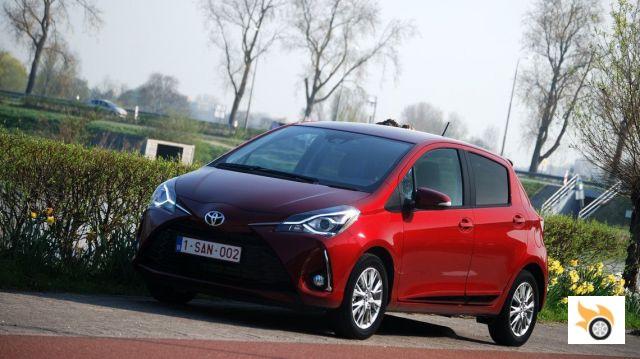
Now it's time to talk about engines, which is what will catch your attention the most. The Yaris 70 has the veteran 1.0 1KR-FE three-cylinder non-turbo, 69 hp at 6,000 RPM. It's not a prodigy of refinement or maximum torque (95 Nm), but it's an option to be valued when the terrain of the area is kind, or when high performance is not required. It can drive on the motorway with a lot of dignity without revving too high. The gears are a bit long, almost reaches 100 km / h in second and third exceeds 130 km / h. When it reaches the injection cut it is like a cut in the fuel injection. When it reaches the injection cut is like crowning a mountain or a chest, smooth, smooth, no tugging.
Only the hybrid has Stop&Start
It's a three-cylinder engine that produces vibrations in the cabin, yes, but the gear lever is always still. It does vibrate, but no annoying frequencies enter the interior. The engine mounts are new on all the engines, the one that will benefit the most is this grinder. It doesn't have less fuel consumption or better performance, but it is noticeable that the noise has decreased. For drivers who are not in a hurry to go everywhere, consumption is just over 5 l/100 km. According to homologation, it is just 4.1-4.3 l/100 km.
A total novelty is the 1.5 VVT-iE, with 111 hp, which replaces the clumsy 1.33 VVT-i. This engine consumes 10% less in the real world (according to Toyota) and doesn't force you to change gear as often as in a grand prix. I have a sour memory of the 2010 Yaris with that engine, at least it had six gears. This one also has six gears, and playing with the gearbox gives good results.
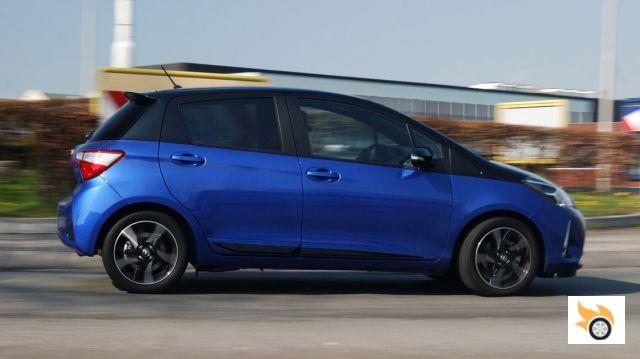
With two occupants, in third gear it does 80-120 km/h in 7.7 seconds, in fourth in almost 12, and in fifth in 17.6.
This engine is an evolution of the 1.33, it is not a derivative of the 1NZ-FXE of the hybrid; in fact, the family is different, this one is called 2NR-FKE. It has the interesting advantage of being able to run in Atkinson cycle at low load, stretching the closing of the intake valves. In those circumstances less energy is lost by pumping and the effective compression ratio is lowered. It can be run at less than 1,500 RPM without the engine complaining or knocking, for example at 50 km/h in fifth gear. It doesn't suffer at all on the flat.
When you put the pedal to the metal it works in Otto cycle, and has a very high compression ratio: 13.5:1 (Mazda reaches 14:1 and it's already a drag). It doesn't have impressive torque, it delivers 136 Nm and Volkswagen's 1.0 TSI delivers 200 Nm thanks to the turbo. Toyota prefers technological simplicity, no turbo and multipoint injection (MPI or indirect), like the other Yaris. I asked Suezawa-san why not to put the new 1.2 Turbo in this car, and he replied that a simpler engine is suitable for this car.
I must thank this gentleman for his honesty. He acknowledged to me that both this engine and the rest of the Yaris range will need particulate filters, the 1.5 VVTi-E gets it in 2018 and the others in 2019. Why not sooner? While the parts themselves won't be very expensive (ADAC says €50 per car), the development is, on average €100 per car. Opponents with three-cylinder direct injection engines will have a harder time complying with Euro 6c, where MPI injection has an advantage.

The new engine is a lot more lively than the 1.33 VVT-i, which was a drag even if you used the gearbox a lot. Even in sixth gear it has discreet recuperative power. Third can be squeezed up to 135 km/h, and once this is reached the injection cut has a sporty touch, as well as its sound. It is, shall we say, the most petrolhead-friendly while waiting for the GRMN, especially when engaging gear after gear on acceleration or downshifts. It's not a bomb, but it's fun. In terms of fuel consumption, it's almost 1 l/100 km more than the three-cylinder, driving in a very similar way.
Regarding the Yaris hybrid, "nothing new on the front". It hasn't changed its fuel consumption rating, only the acceleration noise. With two occupants accelerates from 80 to 120 km / h in about 10 seconds, as the recently tested unit of the 2016 model. With the new instrumentation driving is a bit more intuitive, you can already see on the central dashboard the charge of the high voltage battery, before you had to look at the screen on the right.
Toyota puts as a sales argument that it can drive more than half the time in urban areas with the electric motor, although in the case of my test partner and I, we passed 70% in time (record of the day) and 37% in distance traveled. In other words, without the drawbacks of an electric car, it provides clean mobility in the city, and it has the ECO sticker. On days of high pollution in Madrid and Barcelona will not have problems to circulate. The homologation is the best in the segment, 3.3-3.6 l/100 km.
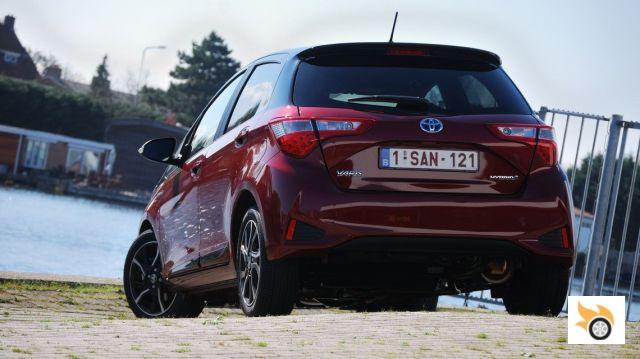
The hybrid version is the one that consumes the least, this should be obvious. Although it is not a particularly heavy car, as it does not reach 1,200 kg, the truth is that the Suzuki Baleno with the SHVS system (semi-hybrid) can be competitive with this one, as it weighs even less. There will be routes in which the Yaris Hybrid consumes clearly less because it doesn't need the thermal engine, but in general they are there. Toyota's technology is much more expensive, Suzuki offers hybrids for less than half the price premium (the same as the Yaris diesel).
One last note about the Yaris hybrid mechanically, and that is that it has the electromechanical steering (EPS) recalibrated to be more stable in a straight line and have a more realistic feel when cornering. I think it does change, although it still needs to make small corrections on the motorway, an ordinary driver won't notice this. For a B-segment, the steering is as it should be, if you compare it to a bigger car with more tread, it's a bit more noticeable.
By the way, the hybrid has a very small fuel tank, 36 litres, the thermal Yaris has a capacity of 42 litres.
The most powerful is undoubtedly the 1.5 VVT-iE, which promises 11 hp more according to the technical specifications (the hybrid combines 100 hp) and does 0-100 km/h in 11 seconds. The hybrid takes 11.8 seconds, the three-cylinder 15.3 seconds. The advantage of the smaller engine is very cheap maintenance and a low purchase price, but the hybrid is the best compromise. Toyota already sells more than 40% of Yaris with electric motor, and believes it will reach 60% next year. It's easy, with no diesel... all Carmena or Colau have to do is contribute to the cause.
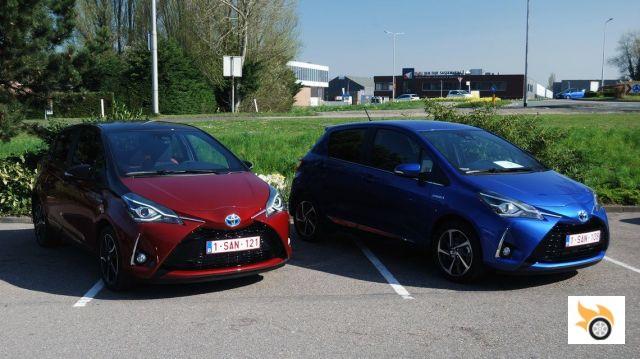
The Yaris range is priced from 10,550 euros without having to finance, or with installments from 125 euros with Pay per drive (the formula most demanded by customers). In Spain comes with more equipment than it had before. For example, Safety Sense will always be standard. This system includes lane change warning, imminent braking warning, traffic sign recognition (except in the basic) and change from low to high beam automatically.
The attack version is the Yaris 70 City, which doesn't have the central screen, nor the instrumentation with TFT screen, nor LED daytime running lights/rear lights, nor some additional sophistications, but it is offered almost at the price of an A-segment car. The rest of the finishes remains as it was: Active, Feel! and Advance, but with better equipment without raising prices. It may not be the cheapest on the market, but it is increasingly interesting in relation to its rivals.
Will the Yaris be updated for the rest of the decade? Yes, although there are some obvious shortcomings compared to its more modern platform rivals in areas such as infotainment or additional safety systems. In terms of engines it is practically up to date, except for the particulate filters (which are not yet mandatory). Only the hybrid is automatic, the others are not even optional. It is one of the few B-segment that has said "no" to diesel, but in our country, because in other European markets the petrol 1ND-TV still has commercial life. That said, the day is closer when Toyota will not offer in Europe any self-developed diesel, as long as they are in demand they will be manufactured by others.
